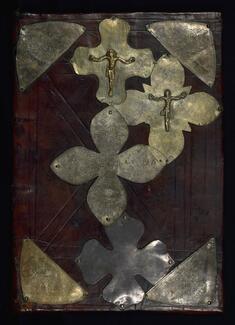Canon Table
(Manuscripts and Rare Books, Medieval Europe )
Provenance
Provenance (from the French provenir, 'to come from/forth') is the chronology of the ownership, custody, or location of a historical object. Learn more about provenance at the Walters.
Bishop Karapet, Poghoskan hermitage, 1193, by commission [see dedicatory inscription, fol. 12v and colophon]; Catholicos John VI [Katholikos Ohannes (Yovhannes VI)], before 1221 [mode of acquisition unknown]; Smbat (nephew of Catholicos John VI), 1221, by gift [presented at the patriarchal see of Hromkla, see colophon, fol. 314v]; In the possession of Gevork', son of Nazluxan, in 1770, [mode of acquisition unknown; see inscription on upper board]; Khodja Hovannes (Yohannes), between 14th and 18th centuries, by gift [from Gevork']; Monastery of St. Thomas, between 14th and 18th centuries [mode of acquisition unknown, undated inscription on fol. 314r states that the manuscript was given to the Monastery of T'umay A?ak'eal (Apostle Thomas) in memory of Xawcay Yovanes, his brother Yulut'lu, father Inap, and mother Zatay]; Nazlu Khatun, 1770 [mode of acquisition unknown]; Ter Hohannes, late 18th/early 19th century [mode of acquisition unknown]; New Nakhijevan, Armenia, before 1889 to after 1903; Henry Walters, Baltimore, after 1903 [mode of acquisition unknown]; Walters Art Museum, 1931, by bequest.
Exhibitions
| 2016-2017 | Jerusalem 1000–1400: Every People Under Heaven. The Metropolitan Museum of Art, New York. |
| 1947 | Early Christian and Byzantine Art. Baltimore Museum of Art, Baltimore. |
Geographies
Turkey, Cilicia, Poghoskan (Armenia) (Place of Origin)
Measurements
Folio H: 10 3/8 × W: 7 5/16 in. (26.4 × 18.5 cm)
Credit Line
Acquired by Henry Walters
Location in Museum
Not on view
Accession Number
In libraries, galleries, museums, and archives, an accession number is a unique identifier assigned to each object in the collection.
In libraries, galleries, museums, and archives, an accession number is a unique identifier assigned to each object in the collection.
W.538.10V



